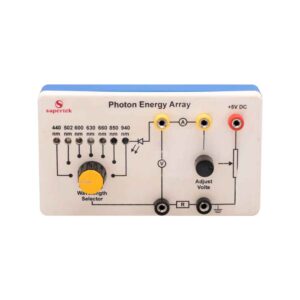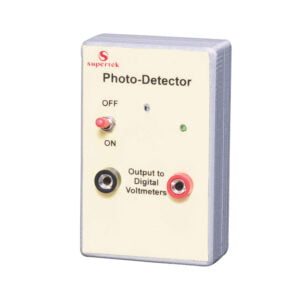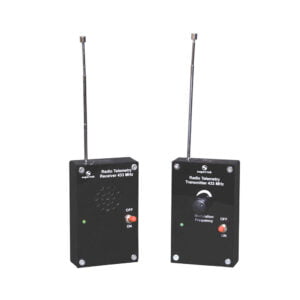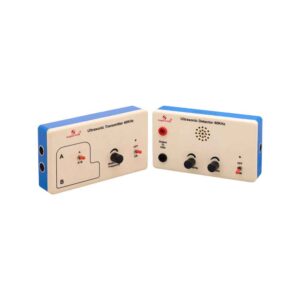Electronics
-
Electronics
Digital Gauss Meter
Digital Gauss meter works on the principle of the Hall Effect in semiconductors. When a semiconductor with current flowing in one direction is introduced perpendicular to a magnetic field a voltage is produced at right angles to the current path. The magnitude of this voltage is proportional to the intensity of the magnetic field. This voltage is called Hall Voltage. This Hall voltage is amplified and calibrated as the magnetic field.
Specifications:
- Range: 0-2 KG & 0-20 KG.
- Resolution: 1 G at 0-2 KG range.
- Display: 3½ digit LED.
- Power Supply: 220 V, ±10%, 50 Hz AC.
- Transducer: Hall probe-In As.
PH93225G -
Electronics
Teslameter
The tesla meter is used for the measurement of flux densities in steady magnetic fields. The unit includes a Hall sensor probe for measuring axial and tangential magnetic fields up to 20mT. The magnetic field probe is provided with a metric scale for measuring distances. In addition to having a digital display, the unit outputs a voltage proportional to the magnetic field which can be measured with a data logger, XY-recorder, or analog multimeter.
PH93240 -
Electronics
Planck’s Constant
Modern LEDs (light emitting diodes) cover the range from deep blue (440nm) to infrared (940nm). By monitoring the voltage at which each LED just begins to emit light a graph of energy input as a function of light emitted frequency can be plotted and an approximate value of Planck’s constant deduced. Complete with viewing tube but without power supply with stackable lead red 2pcs. & black 3pcs.
PH94005 -
-
Electronics
Photo Detector
Photodetector shows that the electromagnetic spectrum extends on either side of the visible spectrum. The detector area is only 1mm dia. so that it can be passed through the visible spectrum produced by a projector and prism. The output is monitored on a multimeter and gives measurable readings from 300nm to 1000nm demonstrating the presence of invisible UV and IR. Requires 9V battery and multimeter with 200mV scale or similar (not included).
PH94010 -
Electronics
RF Telemetry
Supertek RF telemetry system consists of a radio frequency transmitter and matching radio frequency receiver both operating at 433MHz. The system is designed for radio frequency transmission and reception. The radio frequency transmitter sends out a variable audio signal and the radio frequency receiver with a built-in loudspeaker receives the signal. The system enables the teachers to demonstrate a variety of wave phenomenon. The system also enables the properties of the radio communications to be investigated and compared with those of visible light and other wave motions such as audible sound and water waves etc. For the operation of the system, a 9-volt PP3 battery is required.
PH94020 -
Electronics
Ultrasonic Transmitter and Receiver Set
This apparatus consists of a self-contained transmitter and receiver operating in the 40 kHz region. The transmitted wave is modulated at a user-controlled variable frequency of about 2 kHz and this is detected by the receiver which amplifies the signal and drives a miniature integral loudspeaker. Both transmitter and receiver are contained in separate plastic enclosures measuring 175 x 100 x 40 mm which contain all the electronics and the 9 V batteries. The receiver has front panel 4mm sockets so that the output can be monitored on an oscilloscope for more quantitative measurements. The system is ideal for demonstrating sound waves above the hearing threshold and reflection properties associated with sonar etc.
A special feature is the second transducer on the transmitter which can be switched on when required to produce two coherent sources. By moving the receiver along a line parallel to the two sources interference patterns can be dramatically demonstrated simplifying Young’s slits experiment or enabling it to be demonstrated using waves other than light. Complete with batteries, full instructions, and suggestions for use.
PH94022 -
Electronics
Geiger Muller Counter
Supertek’s Geiger muller counter immediately detects particles emitted by radioactive source, most commonly beta and gamma ray particles. The number of clicks heard over a period of time represents relative rate of decay for the radioactive source being sampled.
Specification:
Range:
- γRay – 20 to 120 mR/h
- βRay – 100 to 1800 mR/h
GM Tube:
- Diameter: Ø10 mm
- Total length: 90 mm
Product Features:
- Digital display.
- Continuous operation of up to 20 hours.
- Tare function to set the initial zero values.
- Portable and ergonomic hand-held design.
- For use in schools and other educational institutions.
- Includes rechargeable battery along with charger.
- Transparent cover to protect GM tube from breakage.
- Instantaneous and cumulative values are displayed simultaneously.
PH96060









